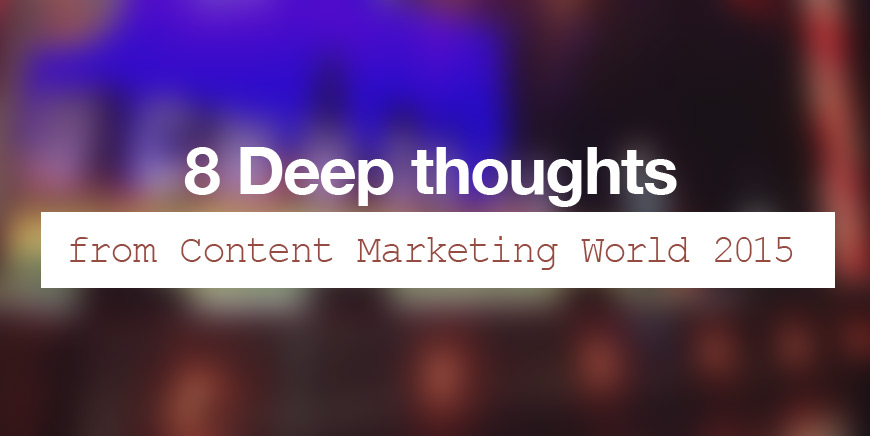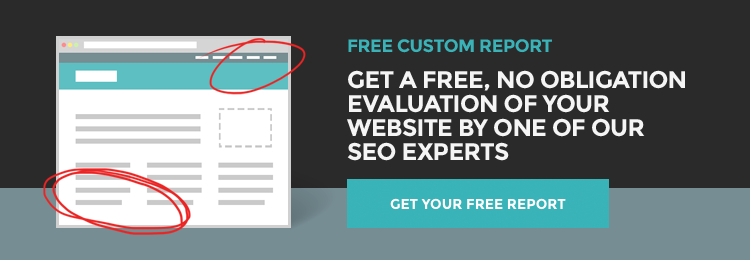
For the fifth straight year, Joe Pulizzi and his team at the Content Marketing Institute drew more than 3,000 marketers and thought leaders to Cleveland for the annual strategy fest known as Content Marketing World.
The event covered its usual big hits with lots of orange candy, plenty of networking events and a Barenaked Ladies concert that proved nothing from the 90s ever truly dies.
Last year I did a post on seven deep thoughts collected at CMW 2014. This year I wanted to do one better. I attended the summit and focused on sessions that could help build relevant storytelling into a content strategy. From those sessions, here are eight unique and interesting thoughts from Content Marketing World 2015. Because the speakers I’m referencing are all experts in their niche, I try to quote them directly or link to their presentations/social media wherever possible.
 1. Build your Tortoise Enclosure for Creative Thinking
1. Build your Tortoise Enclosure for Creative Thinking
Learned from: John Cleese @johncleese
John Cleese is a comedy legend, but he met a mixed reception during his speech because he ripped Cleveland, his hotel and the Republican party. It was all a perfect fit for his dry humor, but it took away from what was probably one of the five best industry keynotes I’ve ever heard.
Once he dug in, he told the story of how he makes himself creative, an exercise most people find counterintuitive. His strategy revolves around building his tortoise enclosure. This was a dive into the art of loafing for creativity, made famous in Guy Claxton’s book, Hare Brain, Tortoise Mind. The hare brain is what we use most often, tackling problems with rational, purposeful and deliberate thinking. This type of thinking is necessary, of course, but unlocking the tortoise mind comes from understanding cognitive research that shows the intelligent unconscious works quietly below, helping us recognize patterns, make connections and think creatively. Slowing down to hear this tortoise mind was at the heart of how geniuses like Einstein and Edison did their work.
This was murky waters to cover in a keynote, but the takeaway of this complex topic was simple: If you want to create, step away from your hare brain activities and find a place where you can think creatively. Cut out the distractions and let your unconscious mind solve the problem for you. After five to ten minutes of it sending you reminders about people you didn’t call and the laundry you left in the machine, it will start to push bits of creativity that you didn’t know you had.
2. Google Cares about Relevant, Timely and Knowledge-Based Content
Learned from Rand Fishkin @randfish
Rand is many things, but first and foremost he is a leader on where the content machine is heading – and this year he shared some mind-blowing thoughts on how most everything you know about traditional SEO is, well, junk.
His full presentations are available all over the web. Like here and here, so I’ll focus on one thing he discussed. Google has built artificial intelligence for its search that is getting smarter all the time, and its focus is query success. What is query success? It is the ability of content on a page to resolve the question or issue of the searcher.
Here’s a good example from Rand. Say you’re thinking of watching that one movie that makes fun of Star Trek. You know the one, it has the Tim Allen in it. Do you search Google for a bunch of longtail keywords around the movie? Probably not. If you’re like most searchers, you ask Google a question: What’s that movie that makes fun of Star Trek?
Guess what, Google knows the answer.
The answer is Galaxy Quest. Go ahead and Google the question and see the answer you get. Google is constantly updating its algorithms and focusing on query success. This means that it rewards good content – content where the searcher stays on the page and takes more action because they’ve found the resolution to their mission. Doing this is less about keywords and more about helpful, relevant content.
3. Search and Social are Total Bros
Learned from Travis Wright @teedubya
Travis Wright had an overwhelming amount of tools and analytics hacks to share, but the easiest takeway was that if you know more about your audience, you can adapt your content to make a better experience for them. As you get better at that, you can pragmatically change the content a user sees. Personalizing the customer journey is a tough nut to crack, but here’s a good starting point: Turn on social listening to get started. One of the easiest tools to get you started is BuzzSumo, which helps you find out which content performs best across search and social to maximize your amplification ability.
4.The Biggest Missed Opportunity in Content is Playing it too Safe
Learned from Ann Handley @MarketingProfs
First, a direct quote from the always-quotable Ann that caught my attention:
To create this content, Ann shared that you must focus on making content:
- Bigger
- Braver
- Bolder
The top challenge for most brands is to make engaging content and, frankly, engaging content isn’t safe. For most brands, it is their story that sets them apart. Content that makes your customer smarter, more aware of what makes your company special and that reached out to their personal interests will have a much higher impact. Be unique. Be a little daring. Don’t be boring.
5. Don’t Confuse Advertising and Content Marketing
Learned from Mitch Joel @mitchjoel
All of my presentation summaries leave out a lot of meat to focus on a takeaway, so I hope Mitch will forgive me for skipping over his wonderful presentation on the sharing economy and how it can impact your content. Because amongst the many big thoughts he dropped, there was one quite simple thought that many content strategists forget: content marketing is not advertising. Your audience has lots of platforms to choose from and it’s well trained at tuning out noise.
As Joel put it, brands that do well don’t see content marketing as advertising. They see it as helpful content and stories for their audience.
6. Focus on Ridding Yourself of ROTting Content
Learned from Anna Hrach @annabananahrach
Look: There’s nothing fun about a content audit. But it is a necessary practice for content marketers for many reasons.
One of the primary reasons is that if you have content, especially content that’s been around for a while, you likely have ROT content. That is content that is redundant, outdated and trivial. It’s content that makes you look bad and doesn’t serve the balance between achieving business goals and helping the user. Simply put, it’s doing more harm than good. Anna’s recommendation? Take the pain of a regular audit to review your content and clean it up. And, hey, there’s an upside. You may find a great piece of content pushed way down in your archives that, with a little clean up, can really perform well.
7. Customer Service Content is the New Marketing
Learned from Jay Baer @jaybaer
Here’s your fun fact from Jay Baer: Companies spend $500 billion on marketing and only $9 billion on customer service. This is a huge missed opportunity. Jay produced studies that showed that even a five percent increase in customer service can lead to up to an 85 percent increase in profits.
What does this have to do with content? You can create content that both addresses your most common complaints and that responds to complaints in a way that helps build your brand loyalty. By responding with content, you can show that you are listening and responding. This will show that you are constantly improving your product or service.
Remember, 95 percent of customers never take the time to complain, they just leave. So do social listening to hear what people are saying about you – or your competition – and address that in a helpful way. If people are saying good things, turn that into content. If people are saying bad things, respond in a public way (with tact) through content that addresses what you’re doing to fix things or describes how it’s fixed. You may not win the complainer back, but you’re likely to pacify many quiet customers who are monitoring the conversation.
8. When it Comes to Content Marketing, Cleveland Rocks
Obviously CMI is headquartered here. But beyond Joe Pulizzi’s deep roots in Northeast Ohio, there are a pile of content creation, strategy and sharing experts in town.
That may sound self-serving since NgageContent is located here, but it’s true. I met great content minds from other cities and countries throughout the event, but I was truly blown away by all of the hometown companies leading conversations and attending sessions. To name a few, I ran into thought leaders from SBN Interactive, Designing Interactive, The Search Guru, Hyland Software and Destination Cleveland. This impressive list shows the sheer concentration of thoughtful content marketers in Cleveland is massive.

